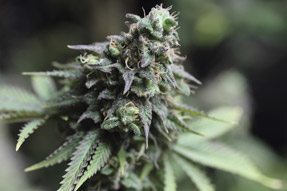Mental health issues, addiction concerns of legal marijuana
Physicians in states that have legalized marijuana should begin to educate and prepare themselves for discussing the perils of recreational use and related illnesses, some of which can be severely debilitating.
With more states legalizing marijuana comes the possibility that more people will become regular users. Physicians in those areas, and their border states, should begin to educate and prepare themselves for discussing marijuana use and treating related illnesses, some of which can be severely debilitating.
“As medical marijuana became legal I started to see more people medicalize their use, but slowly in my conversations with patients, I am starting to see that trend reverse,” said Christine Gilroy, MD, associate professor in the division of general internal medicine and department of pediatrics at the University of Colorado, Denver, who treats a mostly adolescent patient population. “I am seeing that the pattern of marijuana use has changed and that more people are being honest about being heavy, daily users.”

Currently 4 states plus Washington, D.C., have legalized the use of recreational marijuana, increasing access and eliminating legal penalties for carrying or consuming small amounts.
“My big-picture concern is that as society makes marijuana more acceptable and any perceptions of harm fall away that we will see serious issues attached to it,” said Eric A. Voth, MD, FACP, chairman of the Institute on Global Drug Policy.
Mental health issues
In fact, Colorado released a report in January examining health concerns related to marijuana use based on the limited information available to date. The report stated that among adults who reported using marijuana, 64% used it more than 8 times per month, with 36% classifying their use as heavy (27 to 30 times per month).
The report noted that substantial evidence in the literature linked marijuana use in adults with effects on cognitive functioning, memory, and mental health issues. According to Dr. Voth, concerns about mental health should be high on the list of things that internists look out for among marijuana users.
“There is a clear body of evidence that marijuana is inducing psychotic episodes, mania, schizophrenia, bipolar disorder, and more,” said Dr. Voth, who is also a practicing physician at Stormont-Vail HealthCare in Topeka, Kansas. “I have personally treated a dozen cases of marijuana-induced psychosis.”
Dr. Voth pointed to a recent study published in Lancet Psychiatry showing that ready availability of high-potency cannabis in London, England, may be contributing to the increasing number of first-onset psychosis cases, with data indicating an increase in first-time psychosis 3 times higher among cannabis users than among never users.
Similarly, a systematic review published in January in the Journal of Affective Disorders showed that cannabis may exacerbate symptoms of mania in patients with bipolar disorder and significantly increase the occurrence of new-onset manic symptoms.
Dr. Voth anticipated that as more people use marijuana, internists will see an increase in patients presenting with acute anxiety or acute psychosis.
Marijuana dependence
Another clinical problem internists may begin to see is marijuana dependence, according to Dr. Gilroy.
“Part of the issue is that the type of marijuana in the state of Colorado has changed, and it is estimated that the potency, in terms of THC [tetrahydrocannabinol] concentration in marijuana, has increased 10-fold” since the 1970s, and some commercially available strains may have increased 10-fold again since the 1990s, Dr. Gilroy said.
The concern about potency is especially prevalent when it comes to marijuana edibles. Colorado's recommended THC dose for edibles is 10 mg, but many available products, such as gummy bears or candy bars, contain 5 to 10 of these 10-mg servings.
In response to this, in February, Colorado put into effect a series of emergency rules requiring that edibles be packaged in single-serving, child-resistant containers and include no more than 10 mg of THC. Products can be bundled together, but the entire package cannot exceed 100 mg of THC.
According to a review on marijuana dependence published in 2007 in Addiction Science & Clinical Practice, people with marijuana dependence are likely long-term, daily users who continue to consume marijuana despite growing social, psychological, or physical impairments. People with dependency issues may discuss relationship or family problems, financial difficulties, difficulties in school or at work, or sleep or memory problems.
Dr. Gilroy said she frequently diagnoses marijuana dependence during annual wellness visits or physicals.
“It comes up when treating patients for headaches, nausea, school failure, or even panic attacks,” Dr. Gilroy said. “We talk about substance abuse as part of the evaluation and, if they are using daily marijuana in conjunction with any of these problems, we will often recommend to them that some of their problems may be caused by marijuana dependence.”
Benefits and risks
The federal government classifies marijuana as a Schedule I controlled substance, and performance of rigorous, well-controlled trials on its benefits and risks is therefore limited. The Colorado report on health concerns related to marijuana included a survey of WIC (Women, Infants, and Children) clients and found that 63% of current-user respondents listed management of depression, anxiety, or stress as one of their reasons for using marijuana, while 60% listed pain management.
Devan Kansagara, MD, FACP, an assistant professor in the department of general internal medicine at Portland Veterans Affairs Medical Center in Portland, Ore., said that when the legalization of recreational marijuana goes into effect in Oregon in July, he would guess that he will deal with it most in the context of treating chronic pain.
“A lot of chronic pain patients are being treated, through other sources, with medical marijuana, or self-treating with recreational marijuana,” Dr. Kansagara said. “Working for the VA, we can't and don't get involved with medical marijuana, but patients talk about being on it and we know they are on it; whether or not that will change in the future remains to be seen.”
Some research supports a role for cannabis in treating chronic pain, including a small study published in 2010 in the Canadian Medical Association Journal showing that a single inhalation of 25 mg of 9.4% THC 3 times a day for 5 days reduced pain intensity and improved sleep in adults with post-traumatic or postsurgical neuropathic pain. However, a commentary published with the article pointed out that the study adds to only a “trickle” of evidence supporting a role of cannabis in pain management and only looked at 21 patients; it also stated that cannabis may only have positive effects on very specific types of pain.
Policy changes
Dr. Voth's single biggest concern regarding the growing legalization of both medical and recreational marijuana is that the FDA has been removed from the process.
“States are ignoring the FDA and are creating legislative work-arounds to bypass it, so the tried-and-true, long-time established public safety system that we have been able to achieve through the FDA is gone as it relates to marijuana,” Dr. Voth said.
This means that products available to consumers lack any sort of standardized dose curve, making it a “free for all,” he added.
In addition, the Colorado report on health effects of marijuana identified important research gaps, including the need for research on marijuana use with THC levels seen in currently available products, research on potential drug interactions and impairments seen with edibles or vaporizers, and research to better distinguish among health effects in heavy users, regular users, and occasional users.
However, in the meantime, Dr. Gilroy said that Colorado has not done enough to educate the public about use of marijuana, and policies should be adjusted to allocate more of the tax revenue from marijuana sales toward that effort.
“There are marijuana dependence programs, but there are not enough and they are not in the neighborhoods where kids likely need it most,” Dr. Gilroy said.
Public campaigns have addressed marijuana use, she said, but they mostly focus on issues related to public safety, such as driving while intoxicated, and do not address other relevant medical issues related to marijuana use.
Advice for internists
For physicians in areas where recreational marijuana use is about to be legal, Dr. Gilroy recommended incorporating questions about marijuana into a regular screening conversation.
“Just because you feel you know a patient or have seen them for a long time, don't assume that you know whether or not they are using marijuana,” Dr. Gilroy said. “It may be a good time to ask again.”
Dr. Voth encouraged physicians to be on the alert for some of the marijuana-related issues being reported in Colorado, and for other conditions that they might not see on an everyday basis, such as acute psychosis.
“It is not going to be a surprise to me if more physicians are asked by patients if it is okay to use marijuana,” Dr. Voth said. “I still think that physicians have a responsibility to advise patients to only take medications that are researched and have come through the FDA with clear dosing information.”





